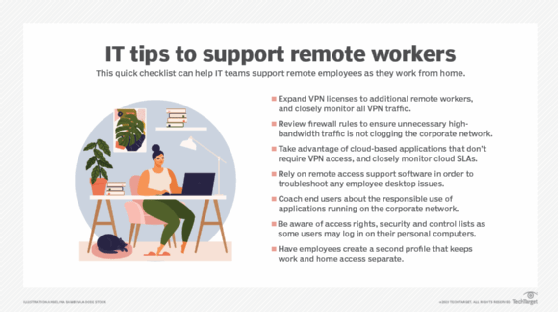
James Thew - Fotolia
Top tips to provide IT support for remote workers
To support employees working from home, network teams should carefully monitor VPN traffic, review firewall rules and rely on remote access support software.
The coronavirus pandemic has, perhaps, forever changed the way businesses operate as remote work is now commonplace. This significant event has especially stressed IT departments, largely because remote dial-in infrastructures were not designed for entire companies.
This unprecedented crisis has required some changes in IT support for remote workers. Service and content providers, for their part, need to assess their capabilities and capacity. And, as one of the most fundamental changes to network infrastructure, users need to adjust to the remote work reality.
As the network edge extends outward to the employee residence, both IT and employees need to be aware of this change and be more understanding of certain workflows. For instance, IT departments should review firewall rules to ensure employees are not routing high-bandwidth video streaming through the corporate network because they forgot to disconnect. Additionally, network teams should monitor VPN traffic diligently to ensure compliance.
Software-defined WAN, for its part, enables IT to better segment or shut down traffic for branch offices that have closed, which limits exposure and reduces the attack surface.
IT adapts to increased telecommuting
Because most VPN applications are licensed by user counts, IT groups will probably need to expand their budgets to cover additional users when supporting remote workers.
As a bit of good news, though, cloud migration is paying benefits. Access to cloud applications may not need to go through headquarters first, removing the need for VPN access for everyone. But this workflow also puts more strain on cloud providers. Consequently, constant monitoring of cloud service-level agreements is also imperative.

Remote access support tools -- such as TeamViewer, Chrome Remote Desktop or even Apple Screen Sharing -- enable continued IT support for remote workers. As some users may log in on their personal computers, IT needs to consider how to handle rights, security and access control lists. A good rule of thumb is to have employees create a second profile that keeps work and home access separate.
Collaboration software -- such as Cisco Webex, Microsoft Teams or Zoom -- can keep teams working together on projects even if they're physically separated. Many companies have set up virtual water coolers in these apps to enable employees to chat about nonwork stuff as a way for employees to still feel connected with each other.
The effect on users, carriers and service providers
Home workers accessing corporate networks on their computers should create a second user profile to keep their personal lives separate from work. Work profiles may require different security settings and antivirus software to help protect corporate networks. Users should have more patience with remote IT staff as they are stretched to the limit and be flexible in allowing this software on their systems.
Also, make sure your router has the latest security patches. For the best remote performance, hard-wiring your PC, even a notebook, helps remove the transient Wi-Fi issues and makes IT support for remote workers easier.
Many home service providers now see more traffic during the day as workers consume what was normally idle capacity. Mobile carriers have also seen large shifts in usage, and many of them removed or increased data caps to adapt to the increased demand in traffic.
For organizations that connect businesses together, a pandemic has wide-ranging effects. Even content providers, such as Netflix and YouTube, reduced streaming on high-definition video to try to control internet traffic, which enables better sharing of those critical pipes.
The coronavirus pandemic affected several entities in the networking world. Together, we can all learn from the health crisis and continue to support remote work infrastructure.








